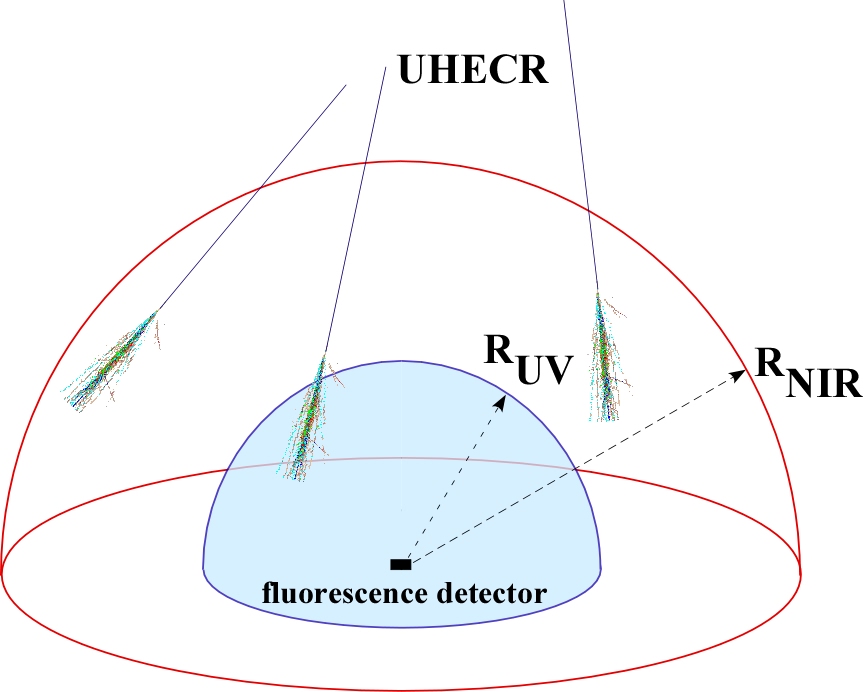 NIRFE
NIRFE
the Near InfraRed Fluorescence Eye
UHECR
In astroparticle physics, an Ultra-High-Energy Cosmic Ray (UHECR) is a cosmic ray particle with an extremely high kinetic energy, far beyond its rest mass and the energies typical of other cosmic ray particles. These particles are significant for astrophysics and fundamental physics theory, because they have energies comparable to the Greisen-Zatsepin-Kuzmin (GZK) limit, which occurs at about 5*10^19 eV (i.e., about 8 J).
The funny side
Useful links
The research
- National Coordinator:
Enrico Conti
INFN sezione di Padova
Via F. Marzolo 8
35131 Padova - Italy
Phone: ++049.9677198
At LNL labs: ++049.8068427 -

- Project started in 2012
- Participants:
INFN and Univ. Lecce
INFN and Univ. Padova
Papers and Presentations
- E. Conti
A possible new technique to detect UHECR: the near infrared fluorescence of the atmosphere
at What Next: Raggi Cosmici, Padova (2014) - E.Conti, G.Collazuol, G.Sartori
Experimental study of the microwave emission from electrons in air
Phys. Rev. D 90, 071102(R) (2014) - E.Conti, G.Sartori, G.Viola
Measurement of the near-infrared fluorescence of the air for the detection of ultra-high-energy cosmic rays
Astrop. Phys. 34 (2011), 333-339 - E. Conti
The Near Infrared Fluorescence of the Air for the Detection of UHECRs
7th Air Fluorescence Workshop (2010) - E. Conti
NIRFE, the Near InfraRed Fluorescence Eye: a new way to detect UHECRs?
Lecce (2012)
NIRFE: trying a new way to detect UHECRs
The atmosphere emits fluorescence light in the Near Infrared (NIR) region, in an analogous way to the well-known fluorescence emission in the UltraViolet (UV). The main features are:
- in the wavelength range 0.8-1.7 um, the emission shows many atomic lines
and molecular bands. The main bands are at 1045 nm, 1230 nm, and 1320 nm.
- the light yield of the NIR fluorescence in that range is about a factor of 5 lower
than the yield of the UV fluorescence in the 300-400 nm range.
 The transmission of the atmosphere in the UV and the NIR region are quite different. In the UV, the
light is absorbed mainly by ozone, and suffers diffusion because
of the large Rayleigh scattering
cross section. All these factors reflect into an UV light
attenuation length of a few tens km. In the NIR region, the Rayleigh scattering is negligible
(it scales as 1/lambda^4) and the light transmission is ruled mainly by the water molecule.
There are however many windows
where absorption is null and the atmosphere is completely
transparent. Between 1 and 2 um, those windows
are centered at about 1.0 um
(infrared Y-band), 1.2 um (infrared J-band)
and 1.6 um (infrared H-band). It is a lucky feature that main emission of the NIR
fluorescence lays in the Y and J bands, and partially in the H band.
The transmission of the atmosphere in the UV and the NIR region are quite different. In the UV, the
light is absorbed mainly by ozone, and suffers diffusion because
of the large Rayleigh scattering
cross section. All these factors reflect into an UV light
attenuation length of a few tens km. In the NIR region, the Rayleigh scattering is negligible
(it scales as 1/lambda^4) and the light transmission is ruled mainly by the water molecule.
There are however many windows
where absorption is null and the atmosphere is completely
transparent. Between 1 and 2 um, those windows
are centered at about 1.0 um
(infrared Y-band), 1.2 um (infrared J-band)
and 1.6 um (infrared H-band). It is a lucky feature that main emission of the NIR
fluorescence lays in the Y and J bands, and partially in the H band.
The main progress of the NIR fluorescence on the detection of UHECRs comes from the possibility
to observe events at very long distance. If R is the light attenuation length,
then the rate of
observable events by a fluorescence detector is proportional to R^2. It is clear therefore that,
since R is longer for the NIR light than for the UV light, there could be a great enhancement of the rate of
observable events.
The NIR fluorescence technique is at a too young stage of development to be implemented as a real detector.
We think that there are the numbers to make a small test prototype which has the main purpose to
demonstrate that the NIR fluorescence technique works and it is capable of detect UHECRs at very long distance,
much longer than with the UV fluorescence.

